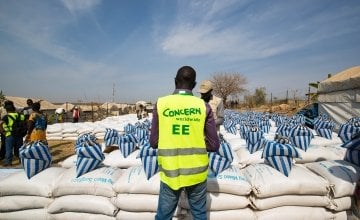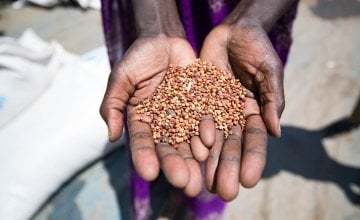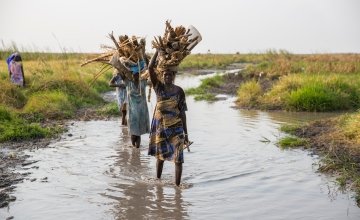
Read our 2023 annual report

Knowledge Hub
Five things to know about conflict and hunger on World Humanitarian Day

As the global community prepares to mark World Humanitarian Day, the joint challenges of conflict and hunger are at the forefront of our minds. Concern’s Humanitarian Policy Advisor, Caitriona Dowd, shares five things to know about conflict and hunger, and what can be done to break the cycle.
1. Conflict is on the rise and is driving humanitarian needs
Around the world, violent conflict is increasing. After several years of growing global peace, violent conflict has significantly increased in the past decade. Not only is conflict increasing, but it’s also the single greatest driver of humanitarian crisis today: over 80% of humanitarian funding goes to conflict-affected contexts.
Conflict has a particularly devastating impact on hunger. After years of steady progress in reducing the number of chronically hungry people in the world, 2016 saw the first increase in over a decade. This rise was driven in large part by increasing levels of conflict. In 2017, famine was declared in parts of South Sudan and alerts were issued for Northern Nigeria, Somalia and Yemen – all in the midst of devastating violent conflict.
2. Conflict directly drives hunger and restricts aid
There are many ways that conflict can contribute to hunger. Where there is an active conflict, insecurity can destroy agricultural land and infrastructure, kill livestock, drive people from their homes, restrict their movement, and prevent humanitarians from accessing communities in need.
I recently worked with Concern’s team in South Sudan to record and share the stories of the people closest the crisis. One member of a mother-to-mother support group I met there reflected on the food security crisis;South Sudan is one of the world’s most conflict-affected and food-insecure countries. Now entering its fifth year of conflict, an estimated 6.1 million are in need of urgent food assistance.. In Bentiu Protection of Civilians (PoC) site, a site for displaced people fleeing conflict in former Unity State, violence in the surrounding area has led to an acute food security crisis and almost total dependence on food aid.tukul [dwelling], you have no access to wood yourself”.
Unfortunately, at current levels, humanitarian assistance reaches less than half of all households in need in South Sudan, primarily due to insecurity. In early 2018, the country marked the tragic milestone of 100 aid workers killed since the conflict began. Sadly, this situation is far from unique to South Sudan. In many conflicts, restrictions on humanitarian access and violence against humanitarian workers themselves, can become deadly weapons of war.

3. Conflict and food insecurity undermine community coping strategies
Beyond these direct impacts, conflict can contribute to hunger in less obvious ways. For example, conflict can transform relationships in a community, undermining trust, social cohesion and support.
In a crisis of widespread poverty, community members and even members of the same family are often less able to help each other. In Bentiu’s PoC in South Sudan, a young man told Concern:
Before the crisis, the relationship was very good. If you see one of your relatives has nothing, you help him. But here in the PoC, there is no exchange – help me, help you, is not there now, because no-one has enough anymore”.
Even in areas far away from the frontlines of fighting, like Aweil North, in the north-west of the country, the impact of the national crisis is affecting communities in similar ways. A group of male farmers there told Concern that before the crisis,
“If you didn’t have something, your relatives could help you. Now, you only struggle for yourself. Before, we used to help each other, but now, that doesn’t happen. Back then, the community used to sit together and see – who is very poor? – and help that person. Now, for this life, our current life, it is much harder than before”.
These changes in the way communities help and support each other can have a long-term impact on resilience, coping strategies and development long after conflict is over.

4. Conflict and hunger affect men and women in different ways
Even within families, the effects of conflict and hunger can be very different. Often, women are primarily responsible for childcare, the collection of firewood for cooking, and feeding their family. In conflict, this can make them particularly vulnerable to sexual and gender-based violence, as well as less visible forms of violence and discrimination.
In discussions across Bentiu’s PoC, women consistently reported that they face the risk of rape if they venture out of the site in search of firewood. “Sometimes women go to collect firewood. When they go outside, people attack and rape them,” a woman in a mother-to-mother support group told Concern. Tragically, this is a near-daily task for many women, who collect firewood both to use for their own household cooking, and to sell or trade for food within the site. Because of this, many of the women had experienced this threat multiple times.
In spite of all the hardships they face, mothers remain hopeful for a brighter future, and focused on the well being of their children. One young woman visiting a Concern nutrition centre supporting mothers spoke for her group when she said: “Our hope is that the country will be at peace. Peace brings good life and good health for children”.
Women can also face less visible forms of discrimination and violence. In Aweil North, a 21-year-old mother recounted her experience of the economic strain the crisis in South Sudan had put on her family, and the resulting violence she had experienced:
Conflict has caused a lot of unhappiness. A husband at home cannot even provide for a family. Before the crisis, there was everything, but now you have to ask the husband for everything – and now there is no money at home, asking can lead to violence […]. The more I ask, the more problems I have at home."
This example shows some of the hidden ways that women and girls suffer as a result of conflict.
5. Making progress on tackling hunger, means tackling conflict and building peace
The accounts above highlight the profound needs and challenges facing communities affected by conflict and hunger – from the direct impact of violence restricting movement and preventing humanitarian access, to the indirect consequences of conflict on community coping strategies and gender roles. However, the stories also reflect the strength, resilience and hopes of communities who have survived extreme violence and are committed to building a brighter future. It is important to remember that even people who have been victimised in violent conflict remain active agents in rebuilding their lives and a more stable, prosperous future for their families, communities and country.

While the task of tackling conflict can seem overwhelming at times, there is a lot that organisations like Concern can do to support communities to build this future. To begin with, we must accept that making progress on the global goal of ending hunger (Sustainable Development Goal 2) requires a commitment to addressing conflict. By responding in a way that is sensitive to the context and designed to reduce conflict’s impacts on different communities and members, humanitarian organisations can help ensure they are reaching those who are most vulnerable and most affected. By supporting local peacebuilding initiatives to rebuild community trust, cohesion and support systems, organisations can contribute to more sustainable development over time.
Interested in learning more?
Read the full report, Conflict and Hunger: The Lived Experience of Conflict and Food Insecurity in South Sudan, below.


